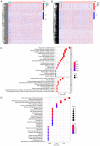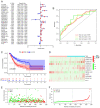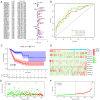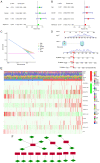Ferroptosis‑related long non‑coding RNAs and the roles of LASTR in stomach adenocarcinoma
- PMID: 35137922
- PMCID: PMC8855154
- DOI: 10.3892/mmr.2022.12634
Ferroptosis‑related long non‑coding RNAs and the roles of LASTR in stomach adenocarcinoma
Abstract
Ferroptosis is a form of programmed cell death that participates in diverse physiological processes. Increasing evidence suggests that long noncoding RNAs (lncRNAs) regulate ferroptosis in tumors, including stomach adenocarcinoma (STAD). In the present study, RNA‑sequencing data from The Cancer Genome Atlas database and ferroptosis‑related markers from the FerrDb data resource were analyzed to select differentially expressed lncRNAs. Univariate and multivariate Cox regression analyses were performed on these differentially expressed lncRNAs to screen 12 lncRNAs linked with overall survival (OS) and 13 associated with progression‑free survival (PFS). Subsequently, two signatures for predicting OS and PFS were established based on these lncRNAs. Kaplan‑Meier analyses indicated that the high‑risk group of patients with STAD had relatively poor prognosis. The areas under the receiver operating characteristic curves of the two signatures indicated their excellent efficacy in predicting STAD prognosis. In addition, the effect of the lncRNA LASTR on proliferation and migration in gastric cancer was confirmed and the relationship between LASTR and ferroptosis was initially explored through experiments. These results provide potential novel targets for tumor treatment and promote personalized medicine.
Keywords: LASTR; TCGA; ferroptosis; lncRNA; prognosis signature; stomach adenocarcinoma.
Conflict of interest statement
The authors declare that they have no competing interests.
Figures








Similar articles
-
Angiogenesis-related lncRNAs predict the prognosis signature of stomach adenocarcinoma.BMC Cancer. 2021 Dec 7;21(1):1312. doi: 10.1186/s12885-021-08987-y. BMC Cancer. 2021. PMID: 34876056 Free PMC article.
-
A novel ferroptosis-related lncRNA signature for prognosis prediction in gastric cancer.BMC Cancer. 2021 Nov 13;21(1):1221. doi: 10.1186/s12885-021-08975-2. BMC Cancer. 2021. PMID: 34774009 Free PMC article.
-
Potential Key Markers for Predicting the Prognosis of Gastric Adenocarcinoma Based on the Expression of Ferroptosis-Related lncRNA.J Immunol Res. 2022 Apr 29;2022:1249290. doi: 10.1155/2022/1249290. eCollection 2022. J Immunol Res. 2022. PMID: 35528617 Free PMC article.
-
Identification of novel key regulatory lncRNAs in gastric adenocarcinoma.BMC Genomics. 2022 May 7;23(1):352. doi: 10.1186/s12864-022-08578-6. BMC Genomics. 2022. PMID: 35525925 Free PMC article. Review.
-
Long noncoding RNAs induced control of ferroptosis: Implications in cancer progression and treatment.J Cell Physiol. 2023 May;238(5):880-895. doi: 10.1002/jcp.30992. Epub 2023 Mar 16. J Cell Physiol. 2023. PMID: 36924057 Review.
Cited by
-
Tracing vitamins on the long non-coding lane of the transcriptome: vitamin regulation of LncRNAs.Genes Nutr. 2024 Mar 12;19(1):5. doi: 10.1186/s12263-024-00739-4. Genes Nutr. 2024. PMID: 38475720 Free PMC article. Review.
-
The Regulatory Mechanism and Research Progress of Ferroptosis in Gastric Cancer.Technol Cancer Res Treat. 2023 Jan-Dec;22:15330338231168498. doi: 10.1177/15330338231168498. Technol Cancer Res Treat. 2023. PMID: 37078206 Free PMC article. Review.
-
Cell death affecting the progression of gastric cancer.Cell Death Discov. 2022 Aug 29;8(1):377. doi: 10.1038/s41420-022-01161-8. Cell Death Discov. 2022. PMID: 36038533 Free PMC article. Review.
-
Role of ferroptosis and ferroptosis-related non-coding RNAs in the occurrence and development of gastric cancer.Front Pharmacol. 2022 Aug 15;13:902302. doi: 10.3389/fphar.2022.902302. eCollection 2022. Front Pharmacol. 2022. PMID: 36046827 Free PMC article. Review.
-
Mechanism and role of ferroptosis in the development of gastric cancer.Clin Exp Med. 2025 May 29;25(1):182. doi: 10.1007/s10238-025-01722-y. Clin Exp Med. 2025. PMID: 40439806 Free PMC article. Review.
References
MeSH terms
Substances
LinkOut - more resources
Full Text Sources
Medical

